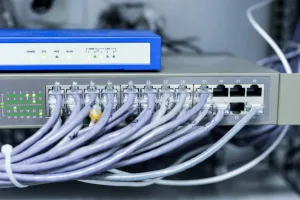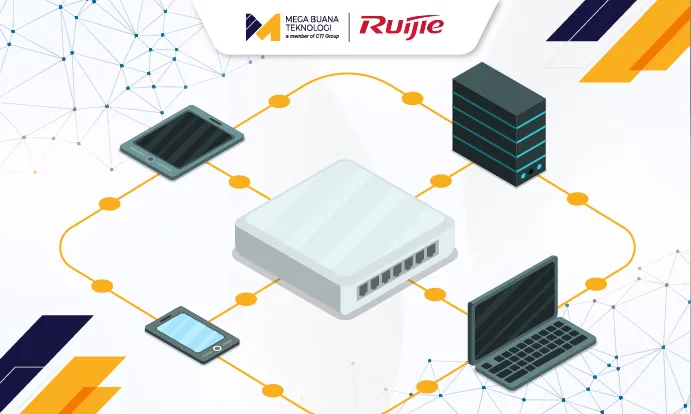Switches are an important component in a network that can connect various devices connected into one network. As a component that is tasked with connecting various devices, the switch functions to help exchange data and information.
Switches play an important role in providing connectivity and corporate networks. So, what is a switch and its function for the network? This article will thoroughly explore the ins and outs of switches to support the modern network ecosystem.
What is Switch?
A switch is a network device that functions to connect several computer devices in a local network (Local Area Network or LAN). This process allows users to exchange data and information to the intended device.
Switches work at the data link layer (layer 2) in the OSI Layer and are capable of sending data based on MAC (Media Access Control) addresses. Switches can be categorized as a type of computer device network that resembles a HUB by exchanging information in a directed manner. However, both have differences in the work system and the HUB price is more expensive.
Unlike routers that connect two or more different computer networks, both LAN and WAN to communicate, switches only forward data packets to a destination device. Switches have several ports that can be used to connect various devices such as computers, printers, servers, and other network devices.
Each port on the switch usually has the same speed, for example 1 Gigabit per second or 10 Gigabits per second. Switches support networking features such as Virtual LANs that allow separation of traffic into isolated logical segments, Quality of Service (QoS) that prioritizes important traffic, and security features such as Access Control Lists (ACLs) to control access to the network.
Switch Function for Network

Switches have several functions for receiving and sharing data between devices. In detail, here are some of the functions.
Looping Avoidance
Can be used to prevent looping when receiving data that has an unknown destination. This data is then forwarded to the destination IP Address via block one of the ports connected to another device.
Penerusan Data Frame
Used to filter and forward frame data to the destination address. This forwarding will then continue to a specific MAC address and port to prevent data transmission collisions.
Address Learning
Can record MAC addresses between connected network devices. When the switch receives data, it will understand the sender’s data to the MAC address.
Types of Switches for Network
There are several types of switches to know, here are some of them.
1. Unmanaged Switch
This switch is the most affordable type in terms of price and is often used for offices and small-scale housing. It functions to manage data flow between printers and computers between other devices. However, this type of switch has a difficult setup and installation process.
2. Managed Switch
It has an API that is easy for users to configure, such as using a console, interfacing, and more.
3. Smart Switch
Carries web-based settings and configurations, making it different from unmanaged and managed switches. The advantage of smart switches is that they are able to manage network needs automatically and can be customized.
4. Enterprise Managed Switch
This type of switch is most often used by large companies for network monitoring and configuration because of its ability to manage a large number of devices.
How Switches Work?
Switches work by connecting a number of devices in a local network through the following steps.
Data Reception
When the switch receives a data packet from one of its connected ports, it immediately reads the source MAC address on the packet. Unlike the IP address which changes frequently, the MAC address is permanent for each piece of hardware, similar to a serial number.
Address Learning
The switch learns the source MAC address and originating port of the received packet. This information will be recorded on the MAC address table inside the switch.
Destination Address Determination
When the switch receives a data packet with a destination MAC address, it will match the destination MAC address with the existing address table. If the destination MAC address is already in the table, the switch will send the packet only to the port connected to the corresponding destination device.
Flood and Learning
If the destination MAC address is not in the address table, the switch will use the “flood” method to send the packet to all ports except the originating port. This is done so that the packet can reach the destination device. At the same time, the switch will learn the destination MAC address of the packet and record it in the address table. That way, on the next packet with the same destination MAC address, the switch will directly send it to the appropriate port without flooding.
Network Segment Separation
Switches can separate networks into virtual segments called Virtual LANs (VLANs). By using VLA, the switch can group devices into network segments that are isolated from each other, so that it can set access policies and improve network security.
Advantages and Disadvantages of Switches
In addition to having advantages, switches certainly have disadvantages compared to other solutions. Here are some of the advantages and disadvantages.
Advantages of Switches
If we break it down, here are the three main advantages of a switch:
- Increased speed and efficiency: By connecting multiple devices simultaneously and providing dedicated paths between the data source and destination, switches avoid the traffic conflicts that often occur when using hubs.
- Network segmentation using VLANs: VLANs allow administrators to divide the network into separate segments to manage policies, improve network performance, and limit the impact of problems on other segments.
- Accurate data delivery based on the device’s MAC address: This minimizes the broadcast of data to all devices on the network, reducing network load and improving data delivery speed.
Disadvantages of Switches
While switches offer numerous advantages, they also come with some drawbacks.
- The cost tends to be higher, as it is capable of performing more complex data processing and has more advanced features.
- Some switches have complex features and configurations, making them difficult to manage for users who are less experienced in computer networks.
- When a switch fails or malfunctions, all connected devices may lose their network connection. This makes the switch a single point of failure that can cause disruptions.
From the various switch options available on the market, you may have to consider a number of factors to choose one that suits your business needs. Ruijie is the right switch solution to accommodate the needs of connecting various devices in a single network.
Read More: Apa itu Access Point, Fungsi, dan Solusi Terbaiknya untuk Jaringan Bisnis
Optimalize Your Network with Ruijie Enterprise Switches
Ruijie Enterprise Switches provide connectivity and efficiency by empowering IT services and enhancing data connectivity as part of a reliable digital infrastructure. Ruijie helps optimize your business network. Ruijie Enterprise Switches offer a range of advantages and variations to suit your specific needs.
Key Advantages of Ruijie Enterprise Switches
Ruijie Enterprise Switches have several advantages such as the following:
- High-performance capabilities: Enables rapid data transmission with minimal latency to support contemporary networking applications.
- Scalability: Facilitates seamless network expansion without compromising performance or efficiency.
- Sophisticated feature set: Offers a comprehensive suite of advanced features including Quality of Service (QoS), VLANs, and Layer 3 routing for optimized network performance.
- Flexibility: Provides the flexibility to configure and deploy the switch to meet specific requirements and adapt to evolving business needs.
- Reliability: Engineered with a robust design to ensure uninterrupted connectivity and minimize downtime.
- Enhanced security: Incorporates advanced security features such as ACLs, port security, and 802.1x authentication to safeguard against unauthorized access and cyber threats.
- User-friendly management: Provides an intuitive user interface and tools for streamlined configuration, monitoring, and troubleshooting.
Ruijie Featured Switch Type
Ruijie has some switches variant as below.
Campus/ Ethernet Switches
Suitable for any size network, it supports Gigabit and 10 Gigabit Ethernet with advanced features such as QoS, VLAN support, and Layer 3 routing for optimal performance.
Data Center Switches
Designed for high-performance cloud computing and infrastructure with low latency, high throughput, and high port density to efficiently handle data-intensive applications and virtualized workloads.
Access Switches
Suitable for connecting user devices such as computers, printers, and IP phones with PoE support to power devices directly over an ethernet cable.
Aggregation Switches
Serves as an aggregation point by aggregating traffic from various access switches and continuing to the central network or data center, equipped with high-speed uplinks and supports LACP and VRRP protocols.
Managed Switches
Equipped with powerful management features to simplify setup, monitoring, and troubleshooting that support SNMP, CLI, and web-based management interfaces for network administration.
Why Should Choose Ruijie Enterprise Switches for Your Network?
Compared to other switches, Ruijie is the right solution for your business network. Here are some reasons that make Ruijie the right solution.
High-Speed Interconnection
Featuring Ruiji’s highest density 400G data center core switches, the solution leverages 25/566G SerDes technology that evolves into 112G SerDes by facilitating a seamless transition from 400G to 800G.
Low-Carbon and Energy Saving
Ruijie with the first liquid-cooled submersible used at data center scale by eliminating high power consumption, saving energy and reducing emissions.
Application-driven and Scenario-innovation
A simple optical ethernet solution that leads the evolution of campus networks, providing an unparalleled experience that can improve data connect
Get Ruijie Enterprise Switches Only at MBT
As an authorized Ruijie distributor and partner, Mega Buana Technology’s (MBT) experienced IT team is ready to help you implement the switch smoothly. MBT as part of CTI Group will assist in the consultation, deployment, maintenance, and after-sales support stages to ensure you avoid trial and error. Contact MBT immediately to start consulting via the following link.
Author: Ervina Anggraini – Content Writer CTI Group




